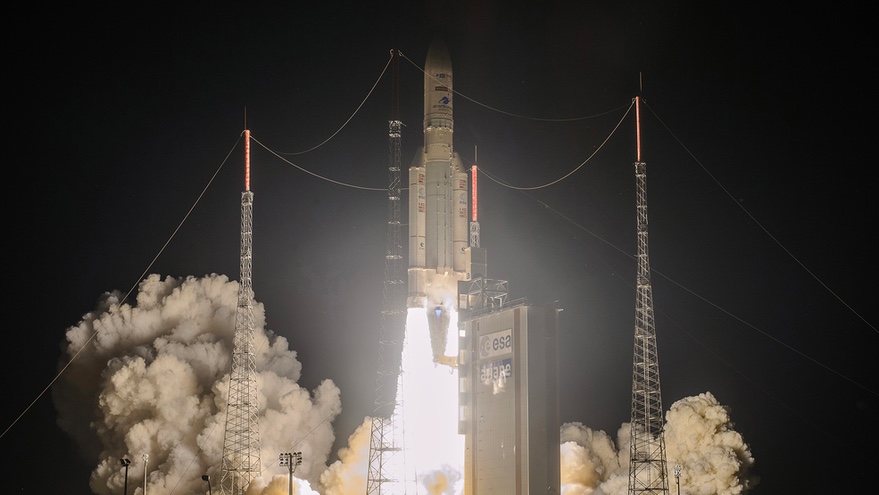WASHINGTON — Ongoing work to address a problem seen on two previous Ariane 5 launches has kept that launch vehicle grounded for months and could delay the high-profile launch of NASA’s James Webb Space Telescope later this year.
The Ariane 5, one of the world’s most reliable launch vehicles, last launched in August 2020, placing two communications satellites and Northrop Grumman’s Mission Extension Vehicle 2 into geostationary transfer orbit. The long hiatus in launches led to speculation there was an issue with the rocket.
In a statement to SpaceNews, Arianespace acknowledged that “post-flight analyses conducted on two recent Ariane 5 launches have indicated the occurrence of a less than fully nominal separation of the fairing, however with no adverse impact on the Ariane 5 flights in question.”
The company did not elaborate on the problem, but industry sources familiar with the issue said that, on both the August 2020 launch and the previous Ariane launch in February 2020, the separation of the faring induced vibrations into the payload stack well above acceptable limits. Neither incident damaged any of the payloads, but raised concerns about the effect on future missions, including JWST.
“We have decided to conduct a set of additional checks with RUAG and ArianeGroup to ensure the best level of quality and reliability; the progress of these investigations remains positive,” Arianespace said. Ruag, which manufactures the Ariane 5 payload fairings, did not respond to a request for comment about the status of that work.
Arianespace declined to give a schedule for upcoming Ariane 5 launches, saying the only date it was publicizing was for its next mission, a Soyuz vehicle carrying another set of OneWeb satellites scheduled for launch May 27. However, NASA officials said there are two Ariane 5 launches scheduled before the JWST launch, which the agency had been publicizing an Oct. 31 date for.
The first of those two Ariane 5 missions is scheduled to carry the Eutelsat Quantum and Star One D2 satellites for operators Eutelsat and Embratel Star One, respectively. In its latest earnings statement May 11, Eutelsat said the launch of Eutelsat Quantum has slipped from the late second quarter of this year to the third quarter, but did not offer a more specific launch date.
At a May 11 media event about JWST, Greg Robinson, program director for the telescope at NASA Headquarters, confirmed there were two Ariane 5 launches ahead of JWST. “They’re going through the process of getting the rocket ready for the upcoming launch, the first of three,” he said. “Once they launch, we’ll be able to launch in about four months after that.”
That would suggest JWST will miss its Oct. 31 launch date, although perhaps only by weeks. An Ariane 5 launch of Eutelsat Quantum and Star One D2 at the beginning of the third quarter, or early July, would allow for a launch of JWST in early November, four months later.
Unlike planetary missions, JWST does not have to launch in a narrow window. “We have launch windows almost virtually every day,” Bill Ochs, JWST project manager at NASA’s Goddard Space Flight Center, said at the event. “We have multiple, multiple opportunities for launch.”
At an April 27 Space Transportation Association webinar, Steve Jurczyk, at the time NASA acting administrator, also suggested a delay in the JWST launch. “There are two Ariane 5 launches before the JWST launch,” he said. “They’ve slipped to the right a little bit.” He said NASA was closely following both preparations of JWST as well as the status of the Ariane 5 manifest.
The current situation is ironic because, for much of JWST’s development, the Ariane 5 had been considered the least risky aspect of the $8.8 billion space telescope. The vehicle typically launched several times a year, and last suffered a total launch failure in 2002. JWST itself, meanwhile, suffered extensive technical problems that delayed its launch by years and added billions to its cost.
At the May 11 media event, though, project officials said final preparations of the spacecraft are going well, and that it should be ready for shipment to French Guiana by late August, a schedule that would support an Oct. 31 launch.
The margin in that schedule has been gradually diminishing, as expected. “When we ship, the schedule margin will be pretty close to zero, but still on plan,” Robinson said, noting there are no “liens” on the schedule for the remaining work before shipment. “Right now we’re in a really good place.”
“We’re getting pretty close to the goal line,” he added. “We just need to punch it over.”
